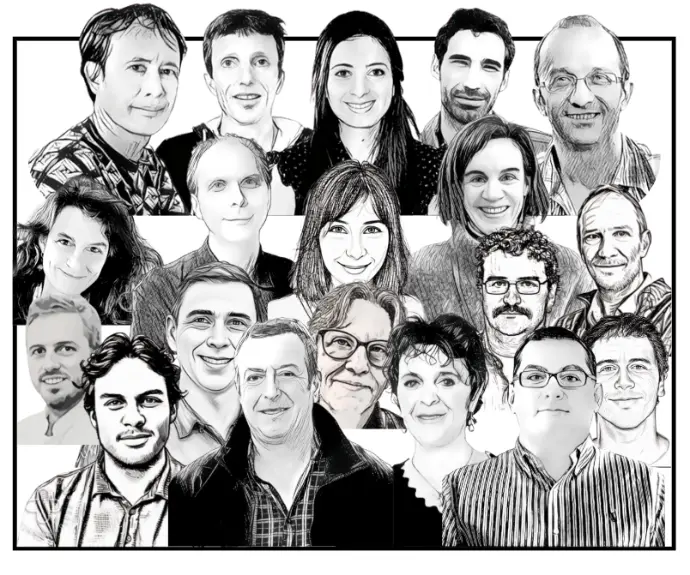
Who is Guillaume Clavé ?
Dr. Guillaume Clavé is an Associate Scientist at CNRS, working within the Chemical Biology and Nucleic Acids Chemistry team at IBMM in Montpellier. He earned his engineering degree in 2005 from École Nationale Supérieure des Industries Chimiques de Nancy and completed his PhD in organic chemistry at Rouen Normandie University in 2009, where he specialized in novel bioconjugation reagents.
He then trained in advanced protein and nanomaterial conjugation during postdoctoral work at CEA and later with Dr. Stéphane Campidelli, focusing on innovative molecular constructs. In 2012, he developed unique hormone-derived fluorescent probes during his time at the Institut de Chimie des Substances Naturelles near Paris. Since 2018, Guillaume has continued his work in Montpellier, developing bioactive molecules and nucleic acid conjugates.
François Boyer & Guillaume Clavé: Chemistry meets plant hormones
François Boyer (ICSN-CNRS, Montpellier) has long explored the chemical world of plant hormones. In 2008, he began working on strigolactones, a recently discovered family of plant regulators controlling branching and fostering symbiotic interactions in the soil.
A few years later, Guillaume Clavé joined his lab as a postdoctoral researcher. Together, they combined their expertise to tackle one of the toughest challenges in the field: how to study strigolactone receptors, when the molecules themselves are so fragile, rare, and expensive to synthesize?
From fragile hormones to smart mimics
The answer was both elegant and powerful. The duo started synthesizing strigolactone analogs, simpler, more stable molecules that preserve the biological activity of their natural counterparts. To track receptor binding, they grafted these analogs with a pro-fluorophore linked to an active group.
The principle is ingenious:
- As long as the analog floats free, the probe is dark.
- The moment it binds to its receptor, the pro-fluorphore linked to an active group is cleaved and fluorescence is triggered, switching “on” the signal.
These fluorescent probes, named GC240, GC242, and GC486 (the “GC” standing for Guillaume Clavé) became the foundation of what is now StrigoLightOn. .
Redefining strigolactone biology
Using these probes, Dr. Boyer and Dr. Clavé made a breakthrough discovery: strigolactone receptors do not follow the classical Michaelis enzymatic model. Instead, they act through covalent, non-Michaelian reactions, a paradigm shift for the field.
This finding not only deepened our understanding of plant development but also opened promising avenues in agronomy, where strigolactone analogs could one day be used to optimize plant architecture or enhance beneficial root–microbe interactions and perhaps even limit the devastating impact of parasitic weeds that exploit strigolactone signals.

Want to watch plant hormones in action?
Explore how StrigoLightOn can light up your research into plant development and symbiosis Here.
Guillaume Clavé's StrigoLightOn publication
An histidine covalent receptor and butenolide complex mediates strigolactone perception, Nature Chemical Biology, 2016. Alexandre de Saint Germain, Guillaume Clavé, Marie-Ange Badet-Denisot, Jean-Paul Pillot, David Cornu, Jean-Pierre Le Caer, Marco Burger, Frank Pelissier, Pascal Retailleau, Colin Turnbull, Sandrine Bonhomme, Joanne Chory, Catherine Rameau and François-Didier Boyer. (https://doi.org/10.1038/nchembio.2147)
A Phelipanche ramosa KAI2 protein perceives strigolactones and isothiocyanates enzymatically, Plant Communications, 2021. Alexandre de Saint Germain, Anse Jacobs, Guillaume Brun, Jean-Bernard Pouvreau, Lukas Braem, David Cornu, Guillaume Clavé, Emmanuelle Baudu, Vincent Steinmetz, Vincent Servajean, Susann Wicke, Kris Gevaert, Philippe Simier, Sofie Goormachtig, Philippe Delavault, François-Didier Boyer. (https://doi.org/10.1016/j.xplc.2021.100166)
Expansion of the Strigolactone Profluorescent Probes Repertory: The Right Probe for the Right Application, Frontiers in Plant Science, 2022. Alexandre de Saint Germain, Guillaume Clavé, Paul Schouveiler, Jean-Paul Pillot, Abhay-Veer Singh, Arnaud Chevalier, Suzanne Daignan Fornier, Ambre Guillory, Sandrine Bonhomme, Catherine Rameau and François-Didier Boyer. (https://doi.org/10.3389/fpls.2022.887347)
Synthesis of Profluorescent Strigolactone Probes for Biochemical Studies, Springer Protocole, 2021. Alexandre de Saint Germain, Guillaume Clavé and François-Didier Boyer.(http://doi.org/10.1007/978-1-0716-1429-7_17)
